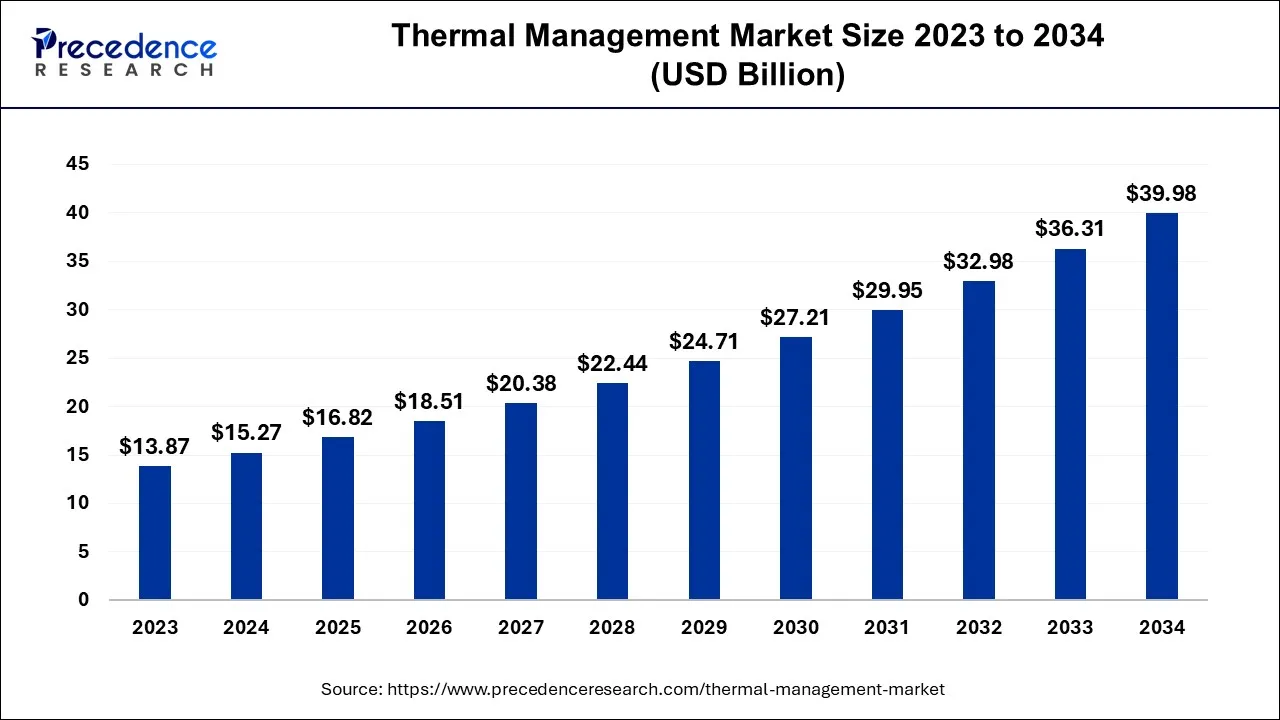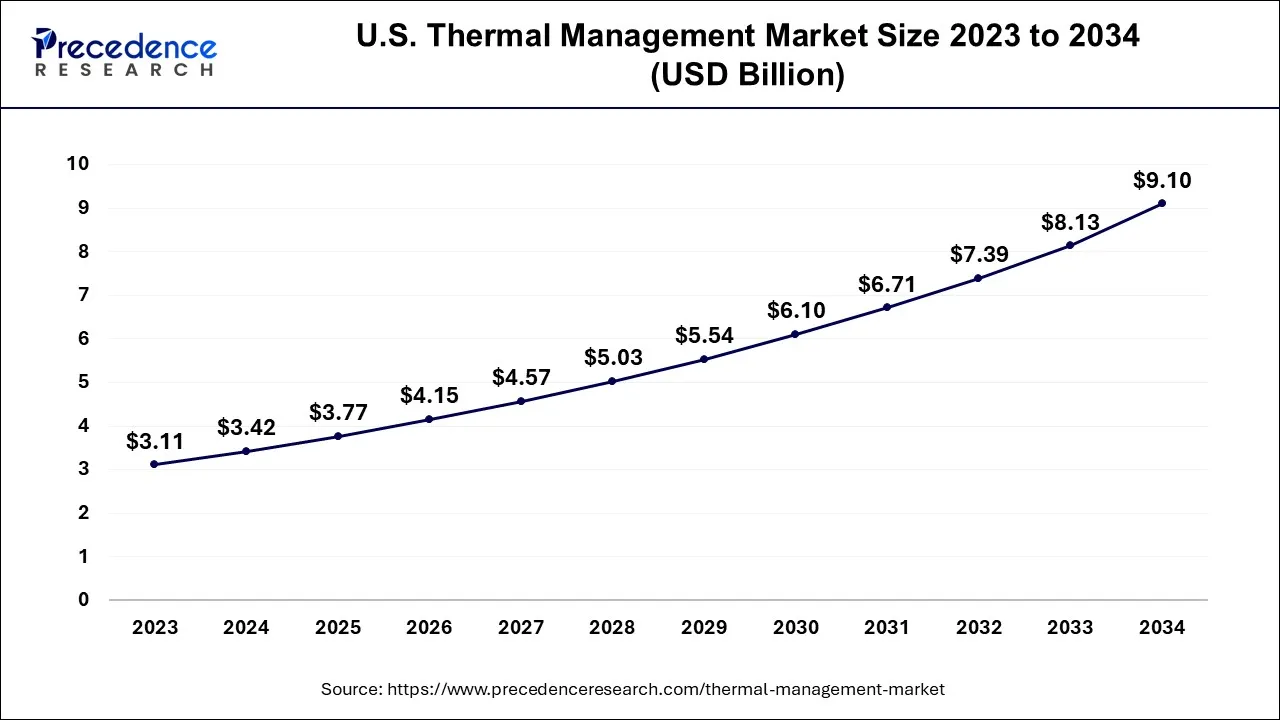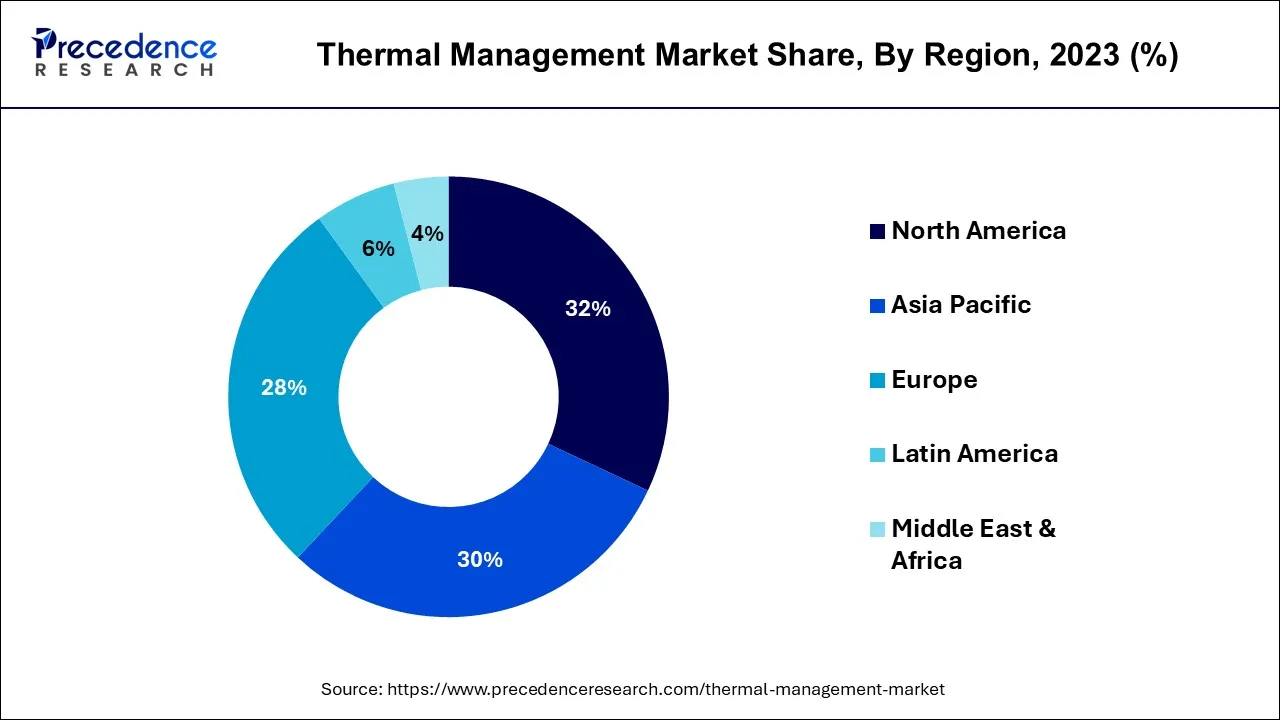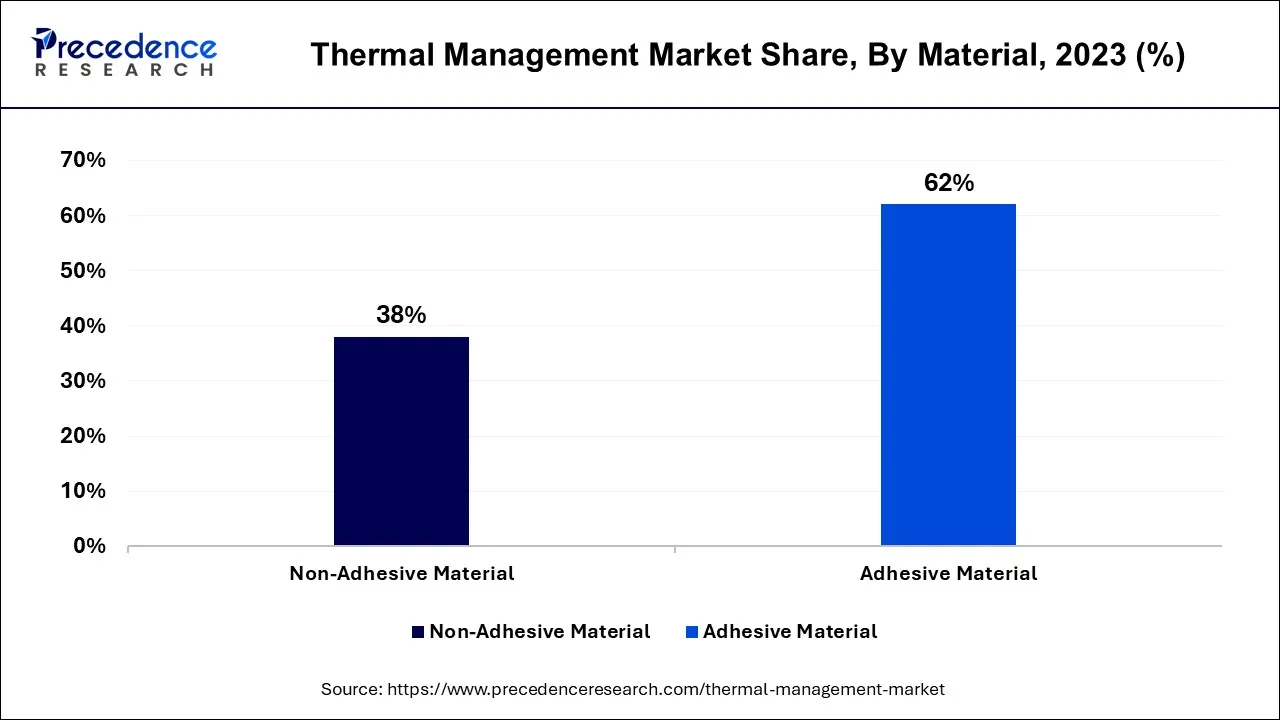September 2024
The global thermal management market size is expected to be valued at USD 15.27 billion in 2024 and is anticipated to reach around USD 39.98 billion by 2034, expanding at a CAGR of 10.1% over the forecast period 2024 to 2034.

The U.S. thermal management market size is accounted for USD 3.42 billion in 2024 and is projected to be worth around USD 9.10 billion by 2034, poised to grow at a CAGR of 10.28% from 2024 to 2034.

North America has held the largest revenue share 32% in 2023. In North America, the thermal management market is witnessing robust growth driven by the increasing adoption of advanced cooling solutions in data centers, automotive, and aerospace industries. There's a growing trend towards more efficient and eco-friendly thermal management technologies to meet sustainability goals. Additionally, the region places significant emphasis on innovations in electric vehicle (EV) thermal management to support the burgeoning EV market.

Asia-Pacific is estimated to observe the fastest expansion. The Asia-Pacific region is experiencing rapid industrialization and urbanization, driving the demand for efficient thermal management solutions. In this dynamic market, there's a growing focus on data center cooling and automotive thermal management, aligning with the region's technological advancements. The push for sustainability and energy efficiency is also promoting the adoption of eco-friendly thermal management technologies across various industries, making Asia-Pacific a key player in the global thermal management market.
In Europe, the thermal management market is characterized by a focus on sustainability and energy efficiency. The region is at the forefront of adopting green thermal management technologies in response to stringent environmental regulations. Thermal management solutions for renewable energy systems and electric vehicles are gaining traction. The European market showcases a strong commitment to reducing carbon emissions through efficient cooling and heating processes across industries.
Thermal management refers to the strategies and technologies employed to regulate and dissipate heat generated by electronic components, machinery, or industrial processes. The primary goal is to maintain optimal operating temperatures to ensure equipment reliability, longevity, and performance. This involves utilizing methods such as heat sinks, fans, thermal interface materials, and liquid cooling systems to efficiently transfer or disperse heat away from critical components. Effective thermal management is crucial in various sectors including electronics, automotive, and aerospace to prevent issues like overheating, component failures, and performance degradation due to excessive heat. By maintaining optimal temperatures, thermal management enhances overall efficiency and extends the operational lifespan of devices and systems.
Industry trends encompass the adoption of advanced materials such as phase-change materials and graphene-based solutions, which offer superior thermal conductivity. Additionally, liquid cooling systems and AI-driven thermal management are gaining prominence for their efficiency and adaptability.
Key growth drivers include the rapid advancement of technology, leading to the development of more powerful yet compact electronic devices. These advancements necessitate effective thermal management solutions to maintain optimal operating temperatures. Moreover, the automotive industry's shift towards electric vehicles (EVs) and the aerospace sector's quest for lightweight, high-performance materials have further fueled the demand for innovative thermal management solutions. However, the market faces challenges related to environmental concerns and the push for more sustainable solutions. The disposal of electronic waste and the environmental impact of certain thermal management materials are areas of growing scrutiny.
The thermal management market, while facing challenges, offers substantial business opportunities. Companies stand to benefit from the increasing demand for effective cooling solutions, particularly in sectors like data centers, automotive, and electronics. Furthermore, the market holds promise for those investing in sustainable and eco-friendly thermal management technologies, aligning with the global emphasis on environmental sustainability. These factors underscore the potential for growth and innovation within the thermal management industry, as it continues to play a crucial role in maintaining the performance and longevity of various devices and systems.
| Report Coverage | Details |
| Growth Rate from 2024 to 2034 | CAGR of 10.1% |
| Market Size in 2024 | USD 15.27 Billion |
| Market Size by 2034 | USD 39.98 Billion |
| Largest Market | North America |
| Base Year | 2023 |
| Forecast Period | 2024 to 2034 |
| Segments Covered | By Material, By Device, By Service, and By End User |
| Regions Covered | North America, Europe, Asia-Pacific, Latin America, and Middle East & Africa |
Rising electronics, IT infrastructure, and automotive electrification
The thermal management market experiences surging demand due to the expanding electronics and IT infrastructure, as well as the electrification of the automotive industry. The thermal management market experiences rising demand due to the growing prevalence of electronic devices, data centers, and the Internet of Things (IoT). Efficient cooling solutions are essential to maintain these systems' optimal performance and prevent overheating. This trend is further accelerated by the increasing adoption of advanced electronics in daily life, spanning smartphones, laptops, and connected appliances.
Automotive electrification, driven by the shift towards electric vehicles (EVs), presents another major growth driver. The increasing complexity of automotive electronics and the demand for extended battery life necessitate advanced thermal management systems. Efficient cooling is essential to ensure safe operating temperatures for EV batteries and components. As the automotive industry pivots towards sustainable and electric mobility solutions, the thermal management market finds itself at the forefront, poised for substantial expansion.
Limited cooling efficiency and reliability issues
Limited cooling efficiency and reliability issues are significant restraints in the thermal management market. Inadequate cooling solutions pose a critical challenge in industries like data centers, where even a minor disruption due to overheating can lead to significant financial losses and operational disruptions. Thermal management inefficiencies result in electronic components and systems overheating, causing reduced performance and potentially premature failures. To mitigate these issues, there is a growing demand for more efficient and reliable cooling solutions in various sectors, driving innovation in the thermal management market.
Reliability concerns are particularly pronounced in applications like automotive and aerospace, where extreme operating conditions demand robust thermal management systems. The failure of these systems can lead to safety risks, which are unacceptable in these sectors. Additionally, limited cooling efficiency can result in increased energy consumption, negating efforts to achieve energy efficiency and sustainability goals. These restraints underscore the need for continuous innovation in thermal management technologies. Addressing cooling inefficiencies and enhancing reliability is crucial to unlocking the full potential of various industries that rely on advanced electronics and systems. Manufacturers must prioritize research and development efforts to overcome these challenges and ensure that thermal management solutions keep pace with the evolving demands of modern technology.
Advanced cooling solutions and sustainability energy efficiency
Advanced cooling solutions are revolutionizing the thermal management market by addressing the increasing heat dissipation challenges in various industries. As electronic devices become more compact and powerful, conventional cooling methods often fall short. Advanced cooling solutions, such as liquid cooling systems, phase change materials, and innovative heat sinks, are enabling more efficient heat transfer and dissipation. These technologies offer higher thermal conductivity and better temperature control, ensuring that critical components operate within safe temperature limits. As a result, industries like data centers, automotive, and aerospace can achieve higher performance levels, longer component lifespans, and improved overall reliability.
Moreover, sustainability and energy efficiency are becoming paramount in the thermal management market. Innovative technologies that recycle waste heat, harness renewable energy sources for cooling, and employ more efficient cooling methods are gaining prominence. Businesses and industries recognize the dual benefits of cost savings and environmental responsibility offered by sustainable thermal management solutions. Consequently, the thermal management market is experiencing a surge in demand driven by the imperative to reduce energy consumption and minimize the carbon footprint across various sectors.
According to the material, the adhesive material sector has held a 62% revenue share in 2023. Adhesive materials in the thermal management market typically refer to thermally conductive adhesives or compounds. These materials are designed to bond electronic components or heat sinks to dissipate heat effectively. A trend in adhesive materials is the development of high-performance, low-thermal-resistance adhesives that enable efficient heat transfer while maintaining strong bonds.

The Non-adhesive materials segment is anticipated to expand at a significant CAGR of 7.8% during the projected period Non-adhesive materials in thermal management encompass substances like phase change materials (PCMs) and thermal interface materials (TIMs). PCMs absorb and release heat during phase transitions, providing efficient cooling. TIMs enhance heat transfer between components and heat sinks. Trends in non-adhesive materials include the integration of advanced PCMs with high thermal conductivity and the development of TIMs with excellent thermal stability and low thermal resistance, improving overall thermal management efficiency.
Based on the device, Conduction cooling devices held the largest market share of 31% in 2023. Conduction cooling devices are components or systems that transfer heat through direct physical contact, typically utilizing materials with high thermal conductivity like copper or aluminum. These devices are crucial for efficiently dissipating heat from electronic components such as microprocessors. A trend in the thermal management market is the development of advanced conduction cooling solutions that offer improved thermal conductivity, reduced form factors, and enhanced reliability, catering to the ever-increasing demand for high-performance and miniaturized electronics.
On the other hand, the Convection cooling devices is projected to grow at the fastest rate over the projected period. Convection cooling devices, on the other hand, rely on fluid dynamics, such as natural or forced airflow, to carry away heat. The market trend for convection cooling devices involves the integration of smart and energy-efficient cooling solutions, leveraging innovations like variable-speed fans, optimized airflow designs, and intelligent thermal management systems to maintain optimal temperatures in various applications, from data centers to electric vehicles.
In 2023, the Installation & Calibration services had the highest market share of 56.8% on the basis of the service. Installation & Calibration services in the thermal management market involve the initial setup and fine-tuning of cooling systems, ensuring they operate at optimal performance levels. A key trend in this segment is the growing demand for turnkey solutions that offer hassle-free installation and precise calibration, reducing downtime and enhancing system efficiency.
The Optimization and post-sales Service is anticipated to expand at the fastest rate over the projected period. Optimization & Post-sales Service encompasses ongoing maintenance, monitoring, and upgrades to maximize the lifespan and efficiency of thermal management systems. This trend is driven by the increasing focus on predictive maintenance, where data analytics and remote monitoring are used to proactively identify potential issues and optimize performance, ultimately reducing operational costs and ensuring uninterrupted operation.
The consumer electronics segment held the largest revenue share of 34.9% in 2023. Growing demand for smaller, more powerful devices with efficient cooling solutions. This trend is driven by the continuous miniaturization of electronics and the need to dissipate heat generated by high-performance components like processors and GPUs. Thermal management solutions for consumer electronics are increasingly focused on compact, high-performance heat sinks and advanced materials to ensure effective heat dissipation while maintaining sleek and slim device designs.
The Automotive segment is anticipated to grow at a significantly faster rate, registering a CAGR of 8.6% over the predicted period. Electrification of vehicles. Electric vehicles (EVs) require efficient thermal management systems to maintain battery temperature and overall vehicle performance. Key trends include the development of advanced cooling systems, such as liquid cooling and innovative materials, to optimize EV battery efficiency and extend their lifespan. Additionally, the integration of smart thermal management systems that adapt to driving conditions and maximize energy efficiency is becoming more prevalent in the automotive sector.
Segments Covered in the Report
By Material
By Device
By Service
By End User
By Geography
For inquiries regarding discounts, bulk purchases, or customization requests, please contact us at sales@precedenceresearch.com
No cookie-cutter, only authentic analysis – take the 1st step to become a Precedence Research client
September 2024
January 2025
January 2025
October 2025